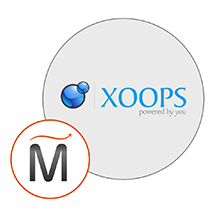XOOPS


Please feel free to contact us
Go
A web application platform for mysql. An added feature of developing small or large community website makes it focus towards the object orientation.
A weblog or a journal is an extra added characteristic through which XOOPS can be used. It comes with various modules like News, Forum, Web Links etc. To go on a higher side , we can say that developers can build their own customized modules such as eshop and not only this, and can seamlessly integrate all their modules with the whole system.
Miri Infotech is launching a product which will configure and publish XOOPS, a web application platform written in PHP for the MySQL database which is embedded pre-configured tool with LAMP and ready-to-launch AMI on Amazon EC2 that contains CMS Bundle, Apache, MySQL, Linux, PHP (LAMP).
You can subscribe to Xoops, an AWS Marketplace product and launch an instance from the product’s Xoops AMI using the Amazon EC2 launch wizard.
Open the URL: http://<instance ip address>
<instance ip address> : IP address of the running EC2 instance.
Step 1: Fill the primary authentication form with the following details –
Username: Admin
Password: <instanceID>
Step 2: select language and click continue
Step 3: click continue
Step 4: click continue.
Step 5: click continue after entering cookie domain.
Step 6: enter the following details and click continue:
Database user: xoops_user
Password: <instanceID>
Step 7: enter the database name: xoops and click continue
Step 8: click continue.
Step 9: click continue.
Step 10: enter your admin details and click continue.
Step 11: click continue on the consecutive screens and enjoy.
All your queries are important to us. Please feel free to connect.
24X7 support provided for all the customers.
We are happy to help you.
Submit your Query: https://miritech.com/contact-us/
Contact Numbers:
Contact E-mail:
Amazon S3 is a simple key-based object store. When you store data, you assign a unique object key that can later be used to retrieve the data. Keys can be any string, and they can be constructed to mimic hierarchical attributes. Alternatively, you can use S3 Object Tagging to organize your data across all of your S3 buckets and/or prefixes.
Yes, customers can optionally configure an Amazon S3 bucket to create access log records for all requests made against it. Alternatively, customers who need to capture IAM/user identity information in their logs can configure AWS CloudTrail Data Events.
These access log records can be used for audit purposes and contain details about the request, such as the request type, the resources specified in the request, and the time and date the request was processed.
Amazon S3 is secure by default. Upon creation, only the resource owners have access to Amazon S3 resources they create. Amazon S3 supports user authentication to control access to data. You can use access control mechanisms such as bucket policies and Access Control Lists (ACLs) to selectively grant permissions to users and groups of users. The Amazon S3 console highlights your publicly accessible buckets, indicates the source of public accessibility, and also warns you if changes to your bucket policies or bucket ACLs would make your bucket publicly accessible.
You can securely upload/download your data to Amazon S3 via SSL endpoints using the HTTPS protocol. If you need extra security you can use the Server-Side Encryption (SSE) option to encrypt data stored at rest. You can configure your Amazon S3 buckets to automatically encrypt objects before storing them if the incoming storage requests do not have any encryption information. Alternatively, you can use your own encryption libraries to encrypt data before storing it in Amazon S3.
Taking control of your site with a content management system also has great advantages as far as your search engine rankings are concerned. All search engines like to see that websites are updated regularly and favor sites that alter their content on a regular basis. Our CMS platform provides search engine friendly web pages and also allows you to create your own page titles and meta tags used by the Search Engines for page rankings.
The CMS is browser-based and will work on both PC and Mac platforms using either Internet Explorer and Firefox. Keyboard shortcuts may vary between the two systems.
When in doubt, avoid using non-numerical or -alphabetical characters.
Requirements gathering is crucial, to make sure you buy on what you need, not on the shiny features that look good in the demonstration.
Another important factor is how easy the system is to use – most likely, the people you’d like to update the site won’t be that technically comfortable, so the best solution is one that has solid usability.
no. That is the biggest myth of CMSs. Most of the time, the real issues in content creation are around people and processes, not the technology. You need to manage your content creation like any other project – with a clear workflow and timetable, and enough people—with the right skills—to handle what you need to create. The CMS will help you get the content on to the site, but the much more difficult challenge is creating it. And computers don’t write very well.
The Web CMS does not require any special software or any technical knowledge to use. It is a web-based platform and can be accessed wherever you have an Internet connection and a web browser. The interface is very similar to Microsoft Word and does all of the HTML coding for you. You can concentrate on the content and not worry about how it will affect the page layout. It also automatically optimizes your site’s content for search, so that when someone searches for information on your site it is more likely to be found.
Modules can be installed/uninstalled/activated/deactivated with a click using the XOOPS module administration system.
Fully supports multi-byte languages, including Japanese, Simplified and Traditional Chinese, Korean, etc
Both admins and users can change the look of the entire web site with just a click of a mouse.
 XOOPS
XOOPS  php
php  apache
apache  mysql
mysql  linux
linux